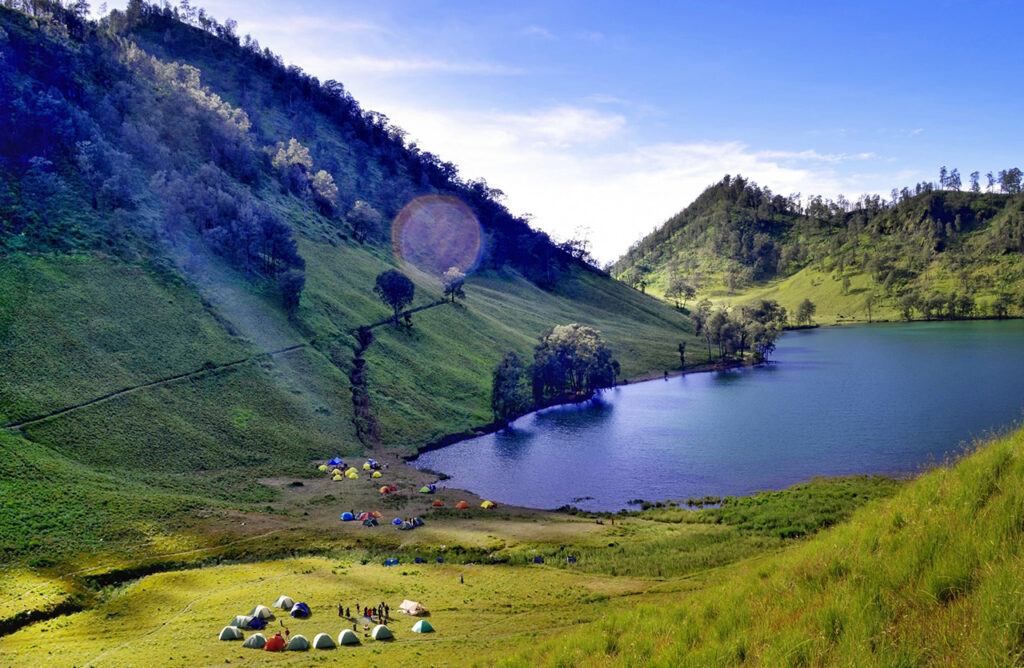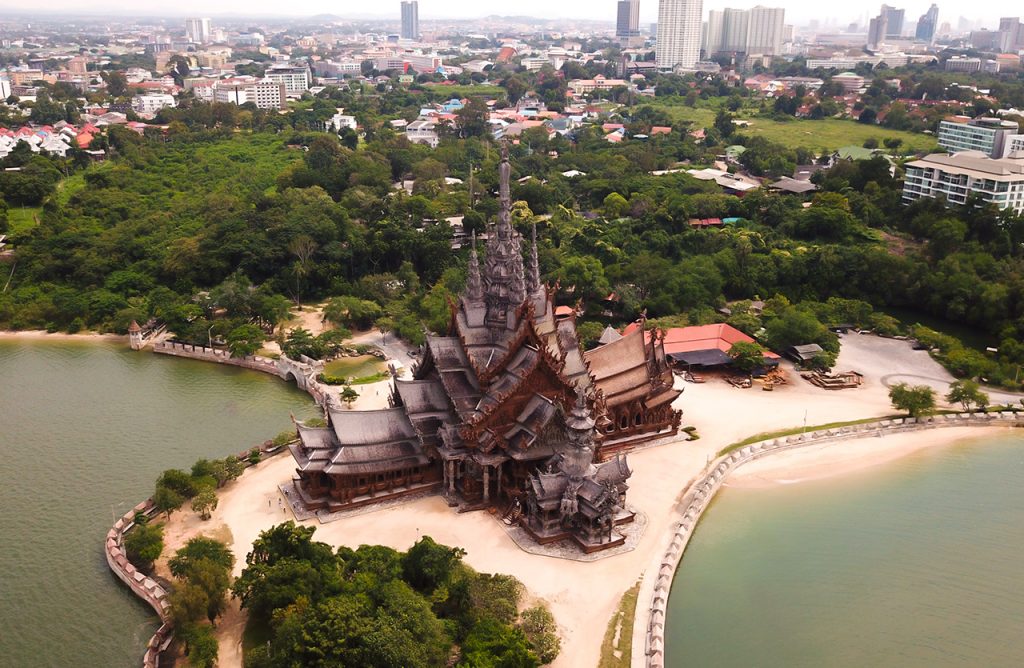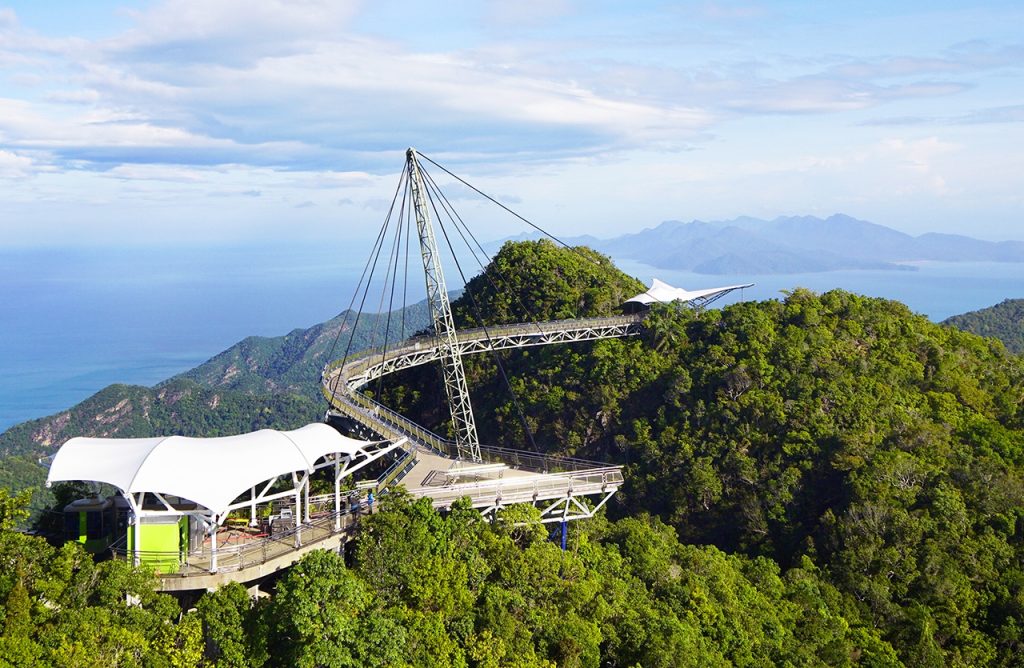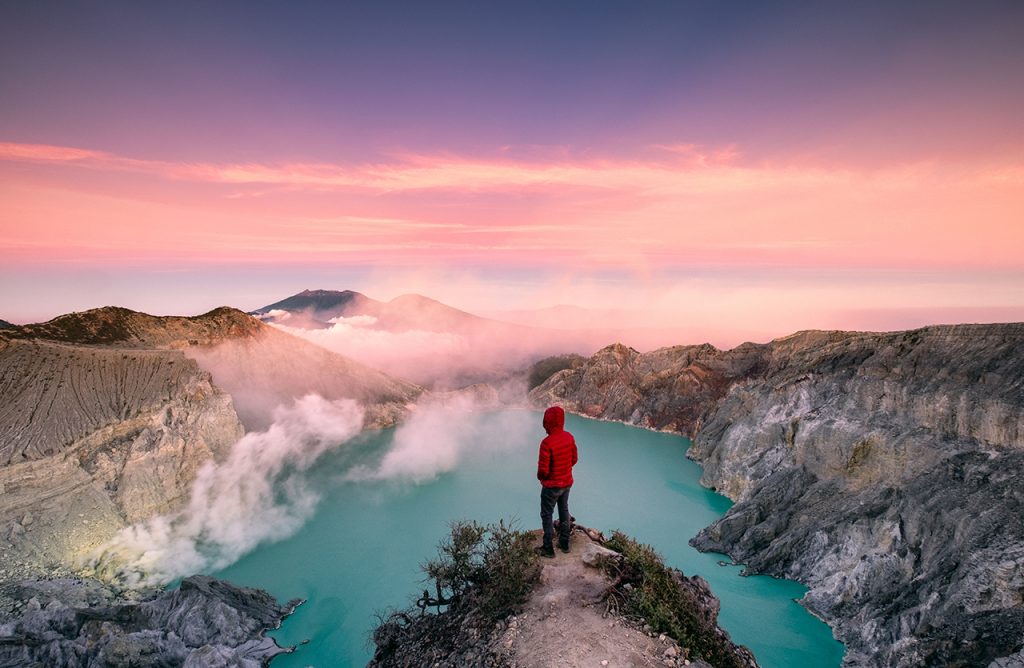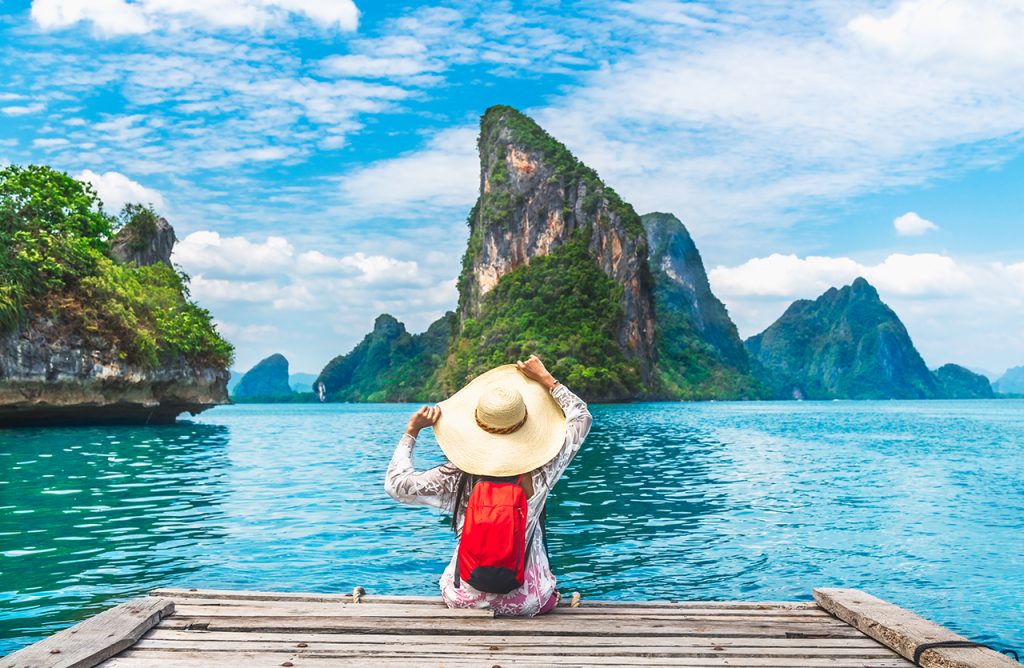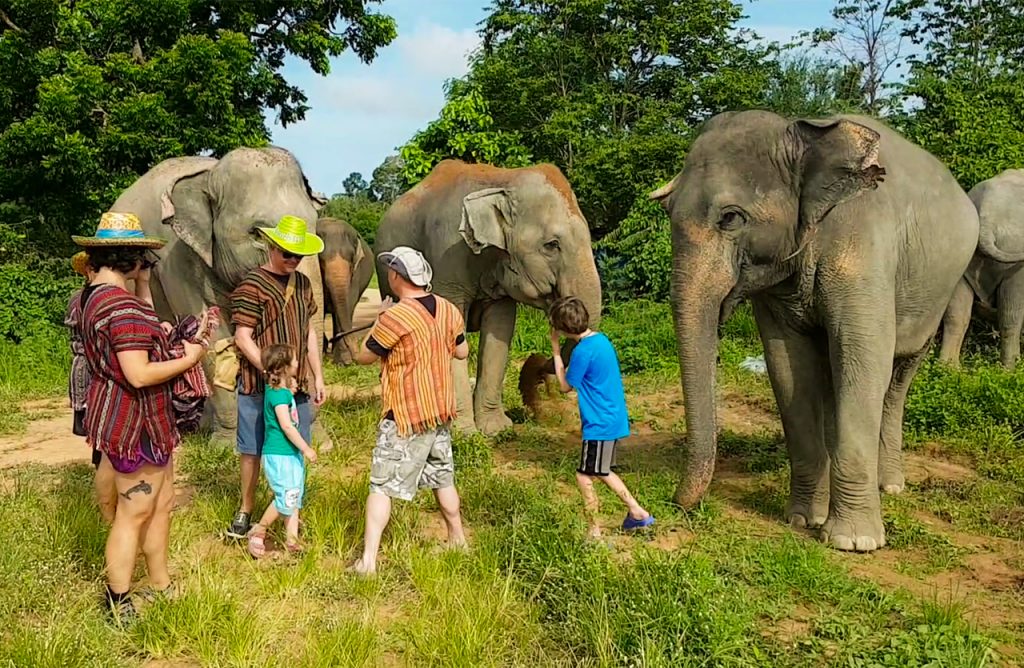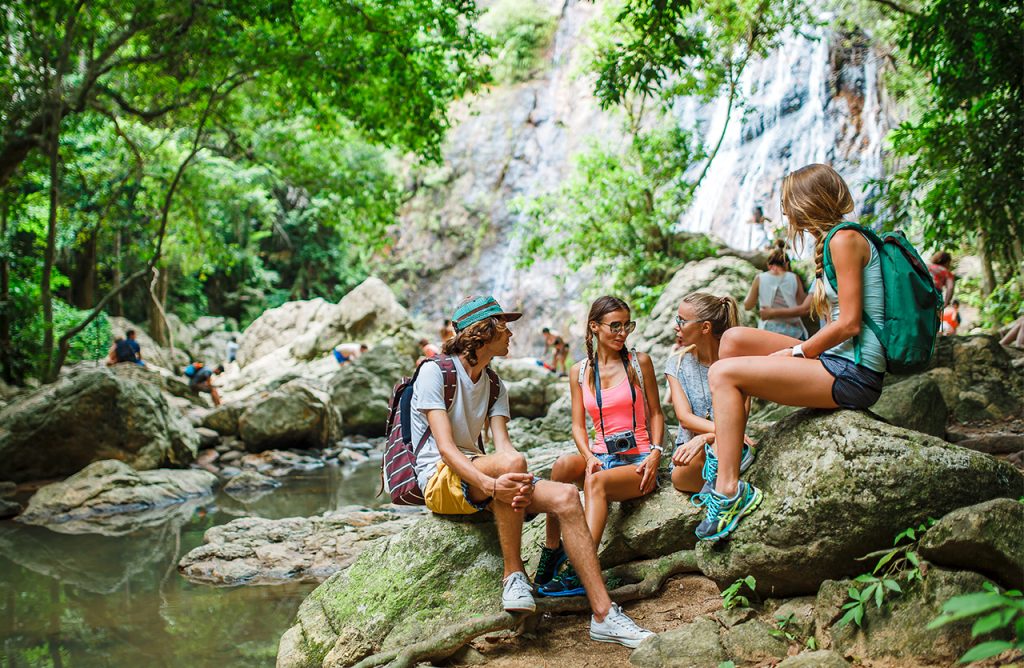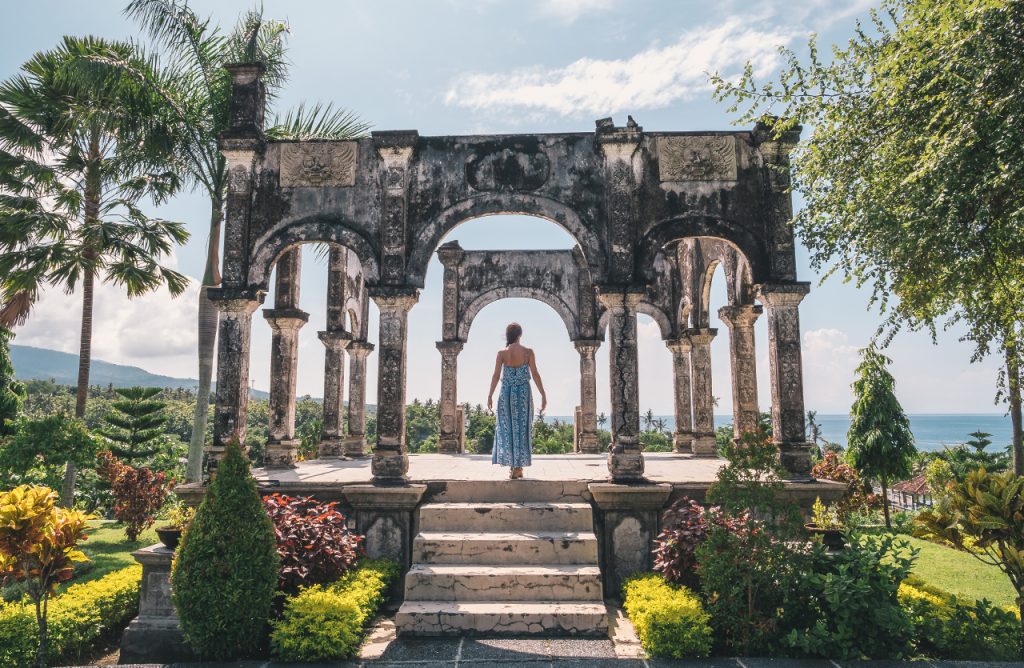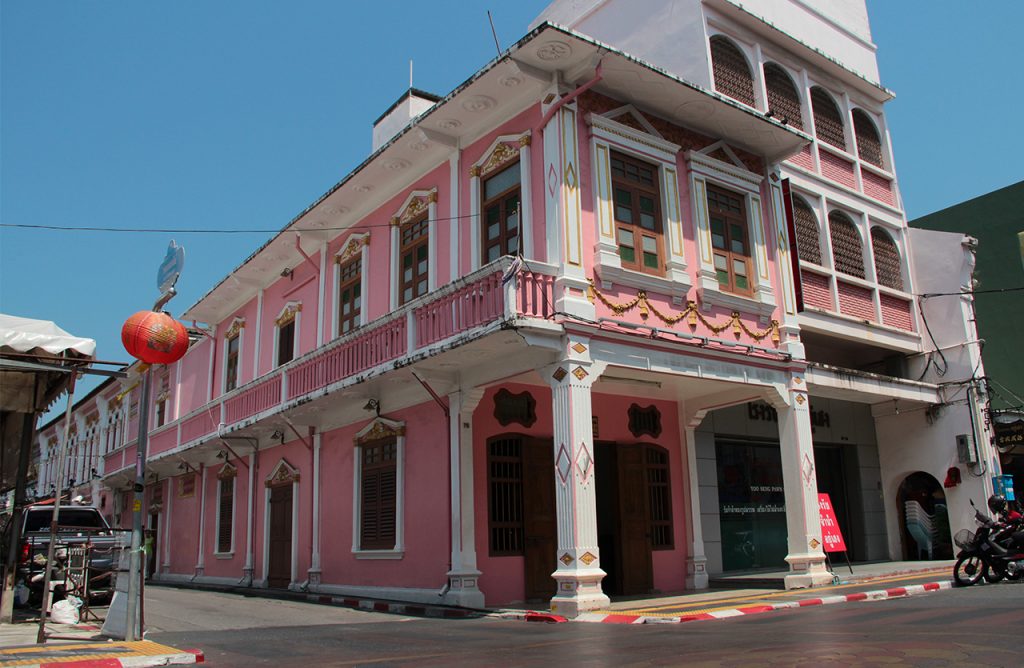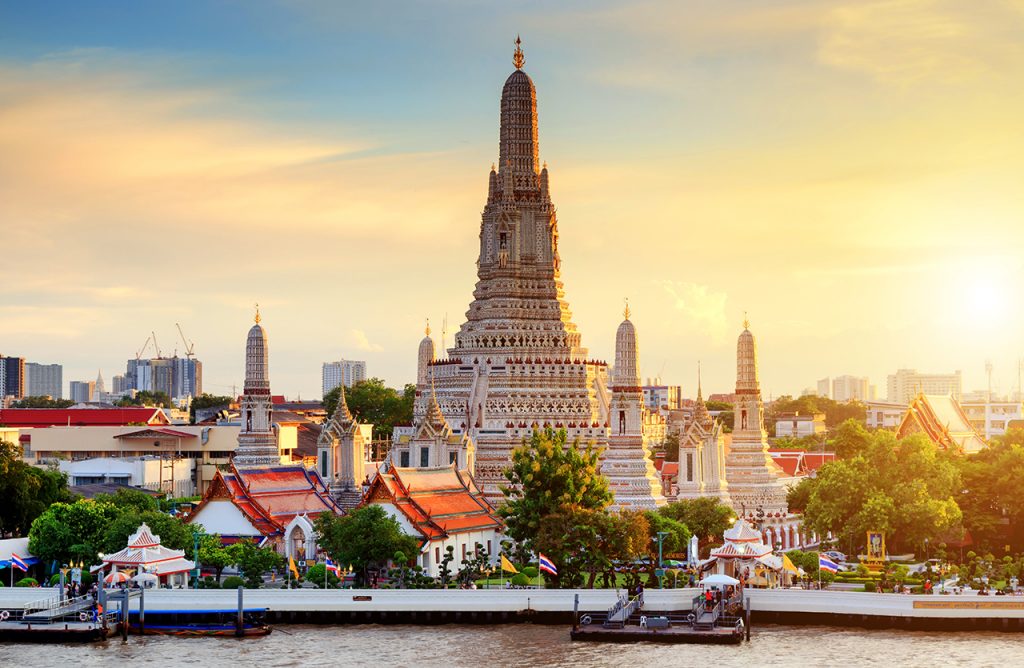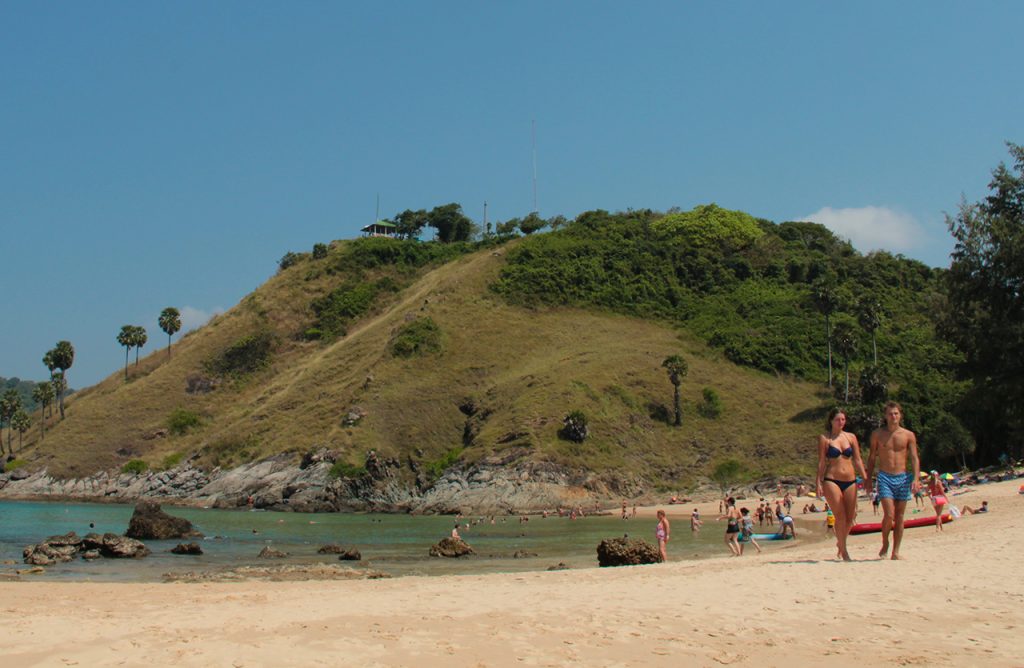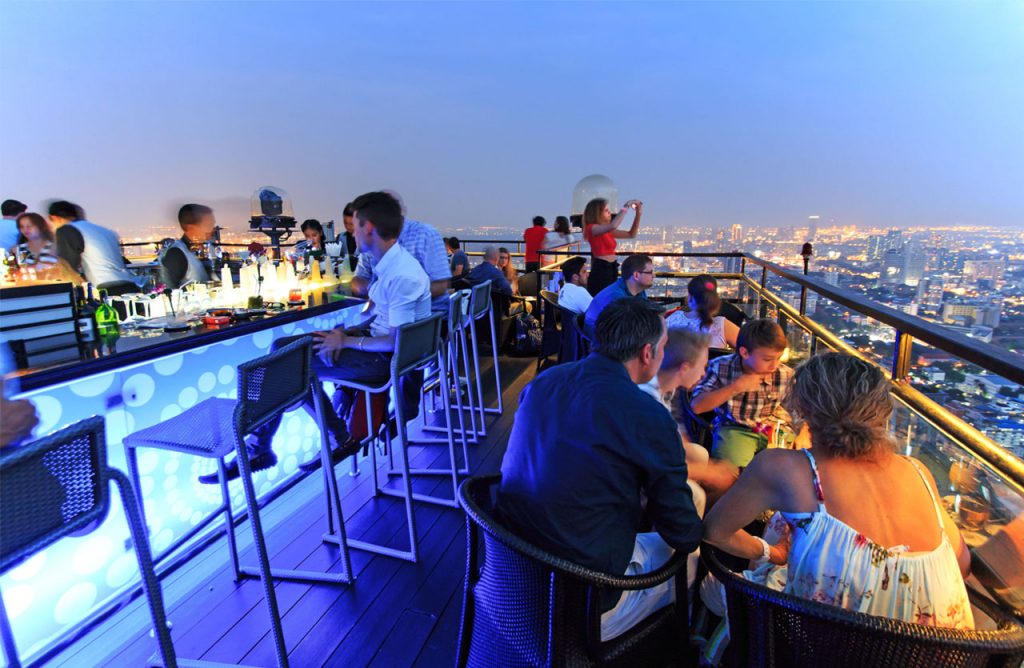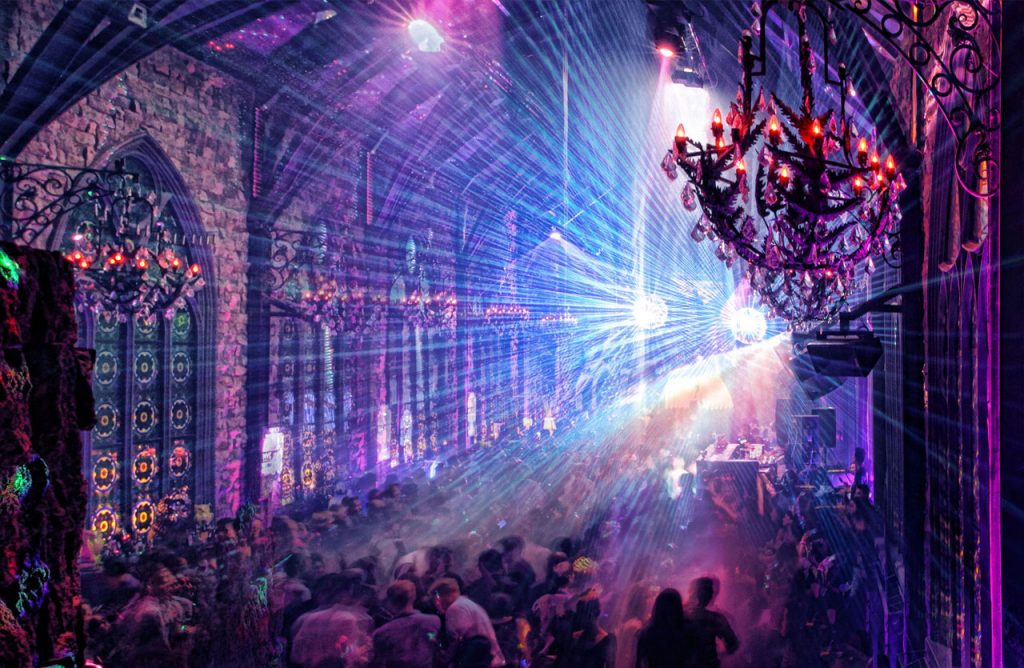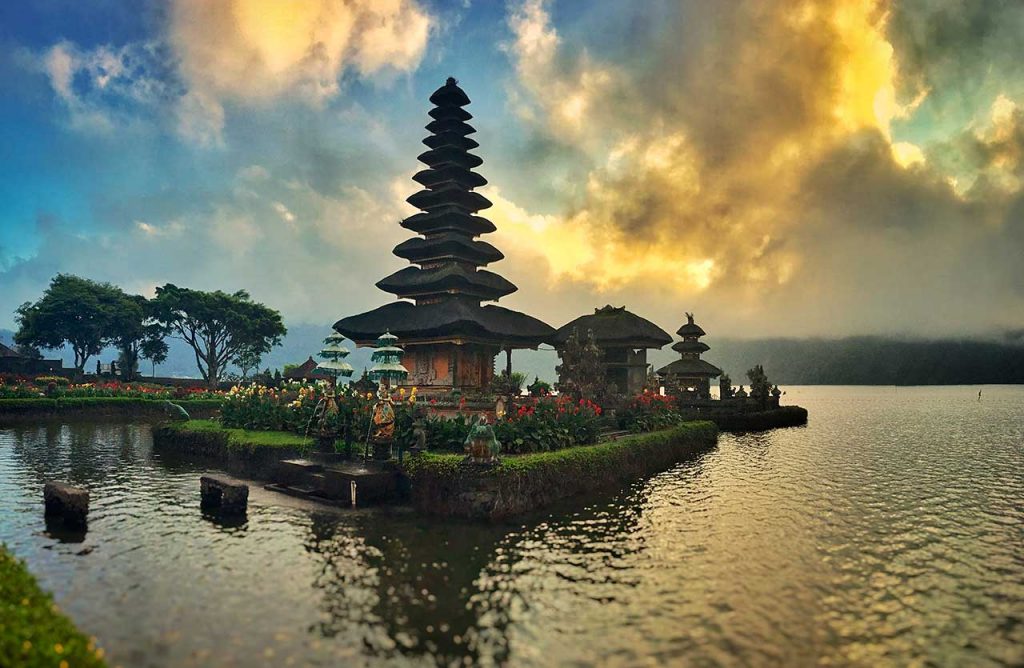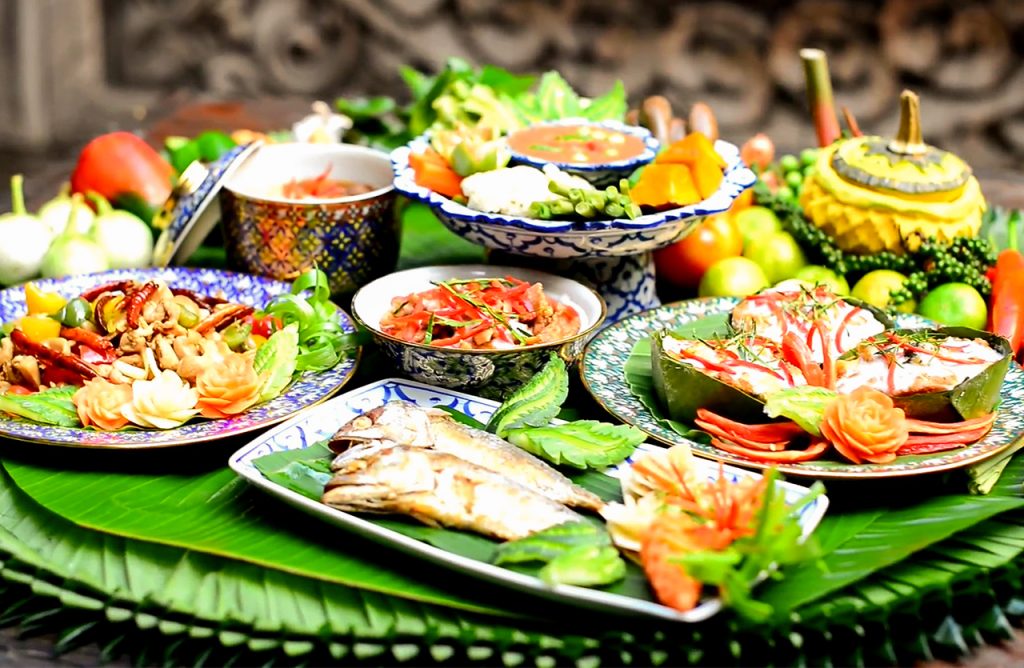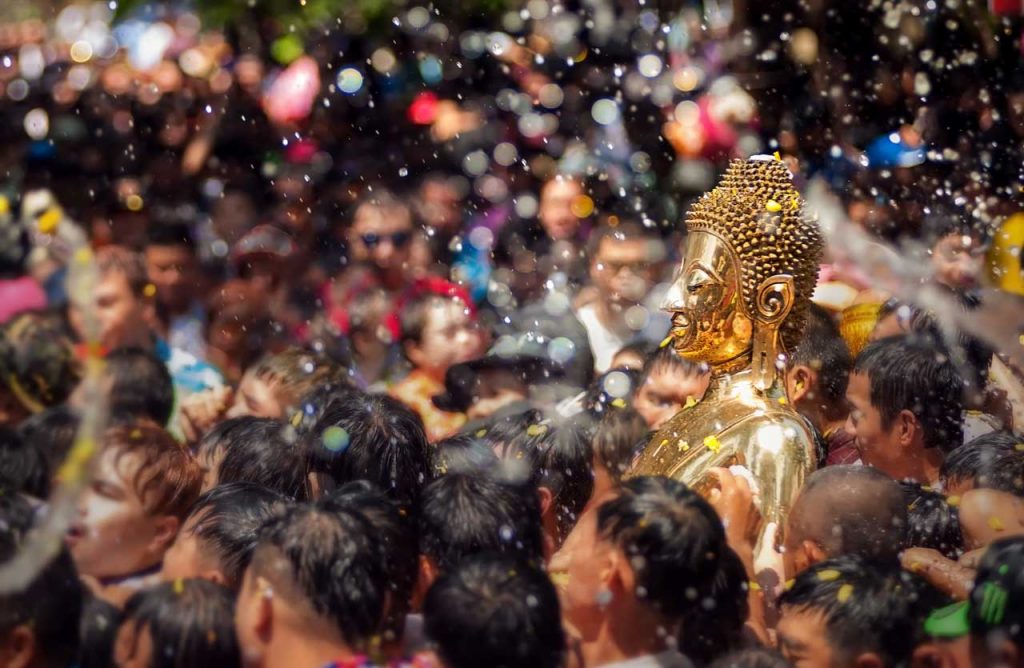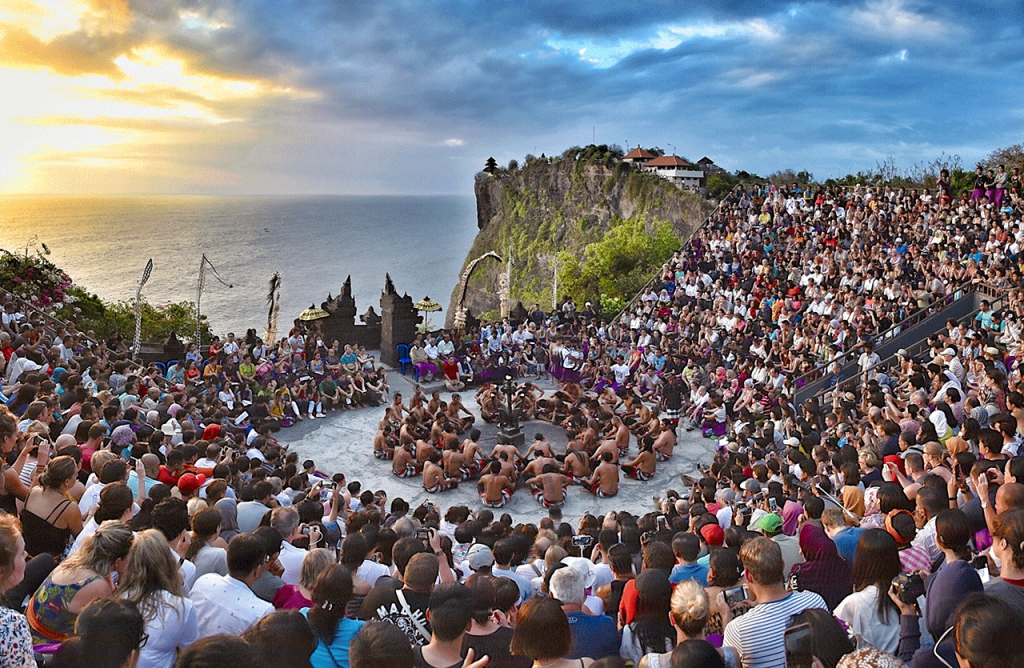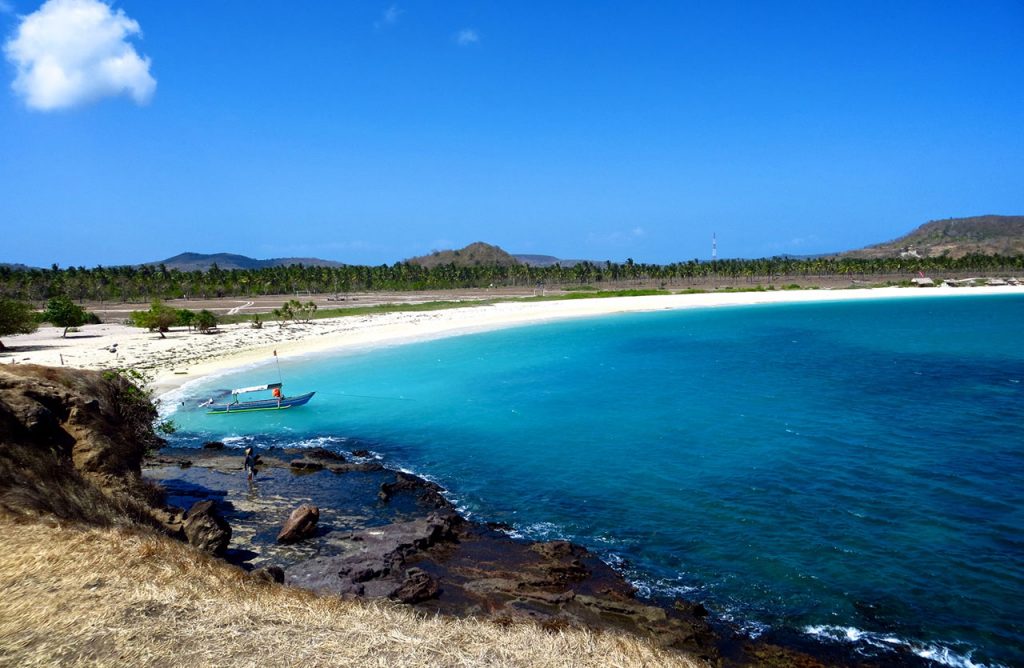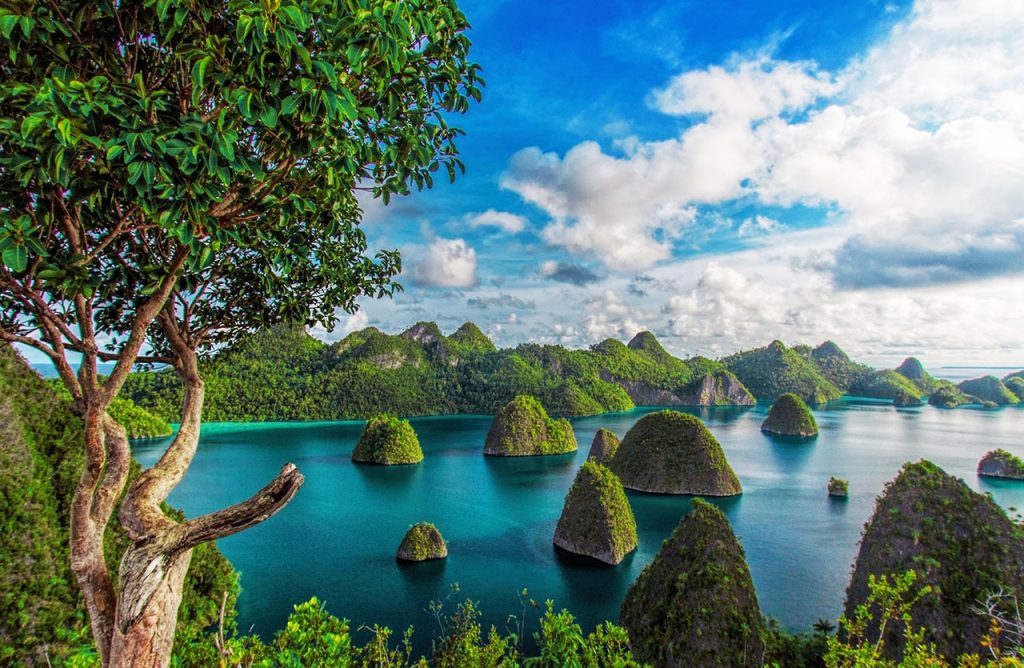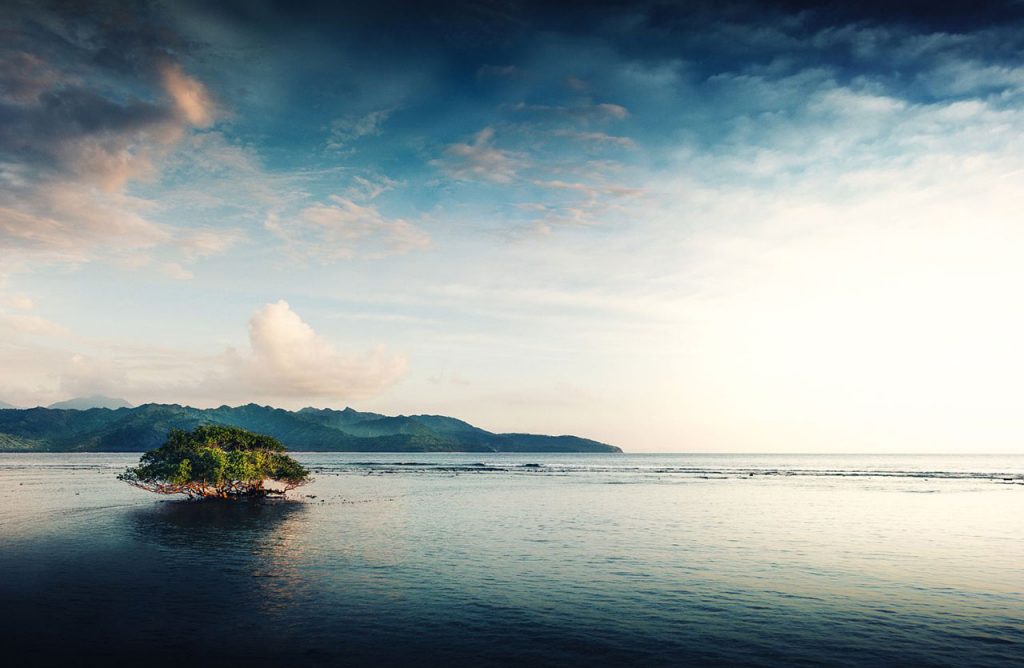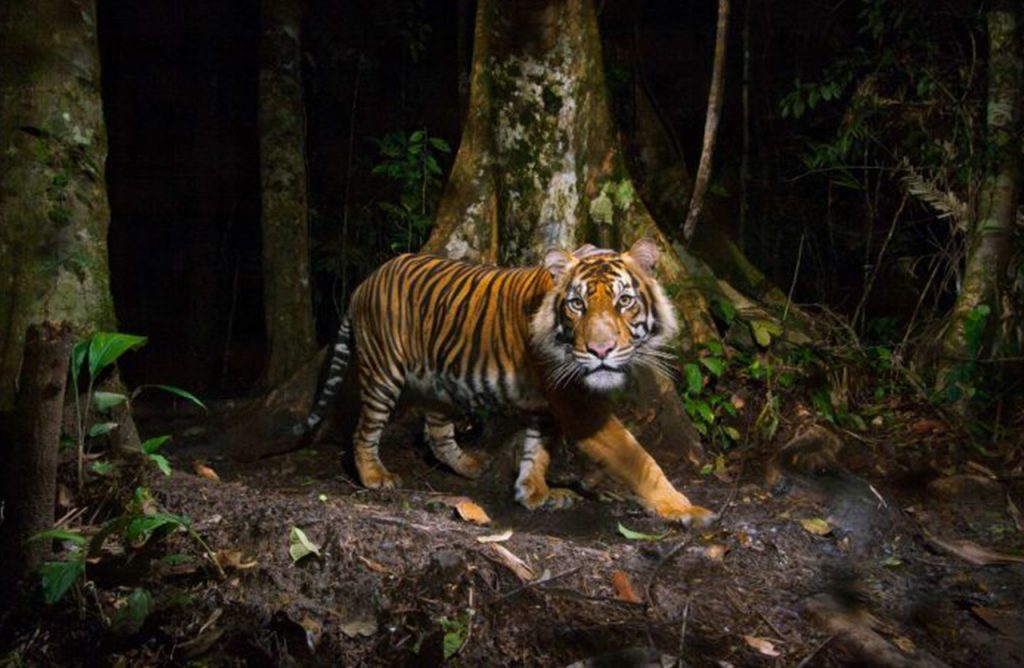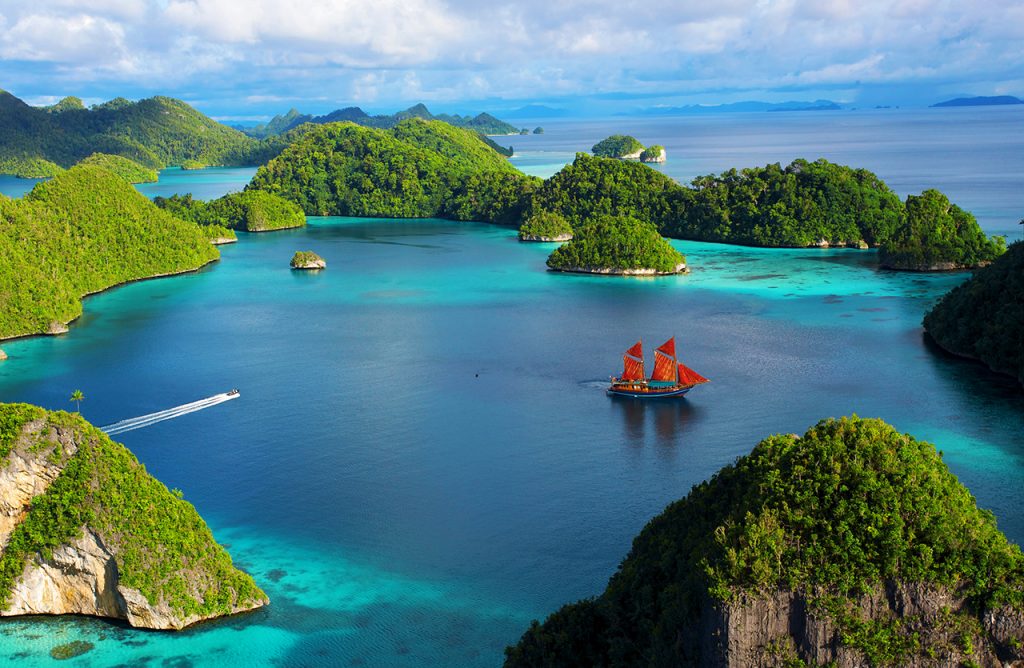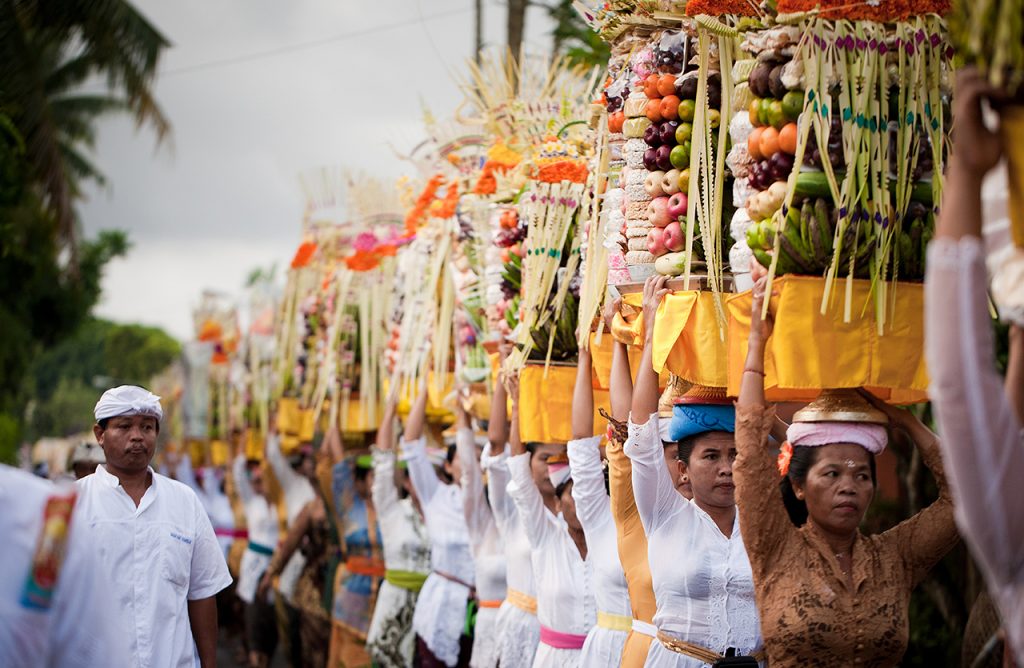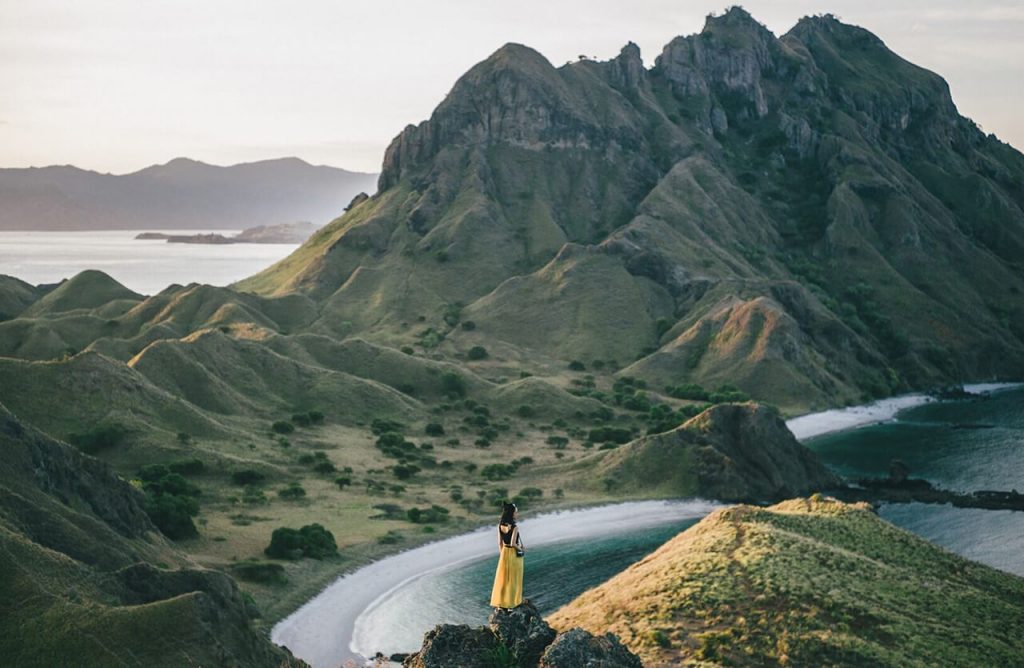

Top 10 Natural Wonders of Indonesia
Indonesia is a cluster of volcanic and tropical islands speckled along the ring of fire, which splits the Indian and Pacific oceans and straddles the equator. More than 17,000 islands make up a star-studded landscape home to volcanoes, jungles, lakes, grasslands, mangroves, exquisite coral gardens and even snow-capped mountains. With such a spellbinding variety of flora and fauna, Indonesia is an Eden of natural wonders just waiting to be explored. In this article, we take a look at ten of the finest natural wonders that this magnificent garden has to offer.



Top 10 Wonders of Indonesia
Indonesia is a cluster of volcanic and tropical islands speckled along the ring of fire, which splits the Indian and Pacific oceans and straddles the equator. More than 17,000 islands make up a star-studded landscape home to volcanoes, jungles, lakes, grasslands, mangroves, exquisite coral gardens and even snow-capped mountains. With such a spellbinding variety of flora and fauna, Indonesia is an Eden of natural wonders just waiting to be explored. In this article, we take a look at ten of the finest natural wonders that this magnificent garden has to offer.

1. Mount Bromo
Located in the Bromo-Tengger-Semeru National Park beside Mount Semeru in East Java, Mount Bromo remains one of the most active volcanoes in the world. Standing at 2,329 metres tall, Bromo is the most iconic and most hiked mountain in all of Indonesia. The main cone sits smouldering inside the massive Tengger caldera, covering an area of 10km and surrounded by the Laut Pasir (sea of sand); a desolate plateau of fine black volcanic sand and rock. Trekking across the vast rippling plain or traversing on horseback, travellers can get a unique panoramic view of a spectacular natural wonder. Visiting Bromo is an experience that is truly out of this world.
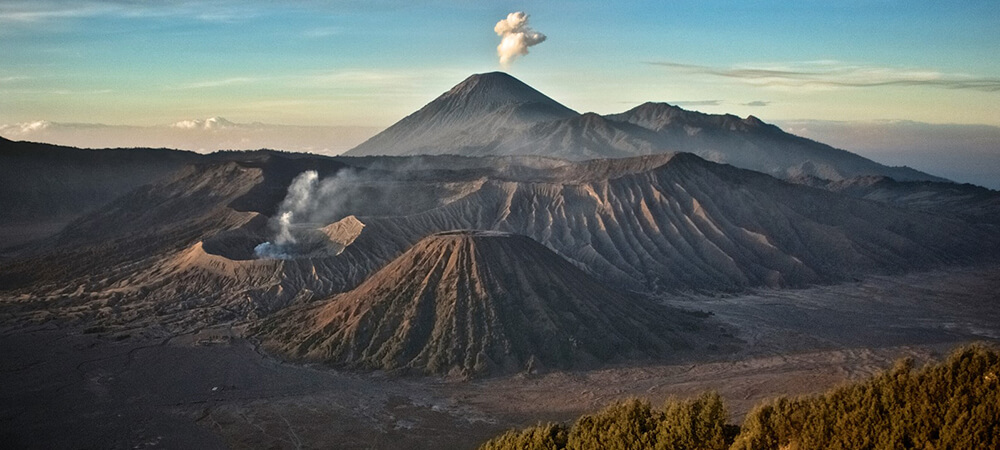
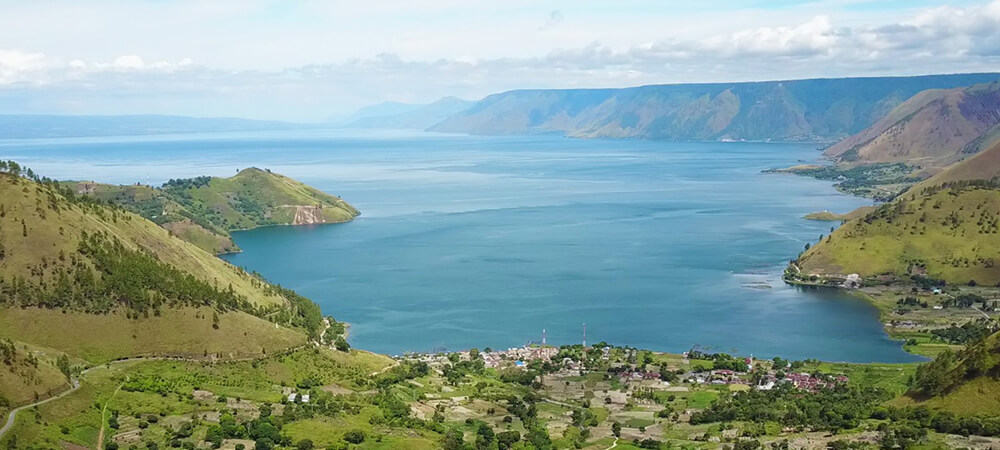
2. Lake Toba
At over 1,145 square km and with a depth of 450 meters, Toba is the largest lake in Southeast Asia and one of the deepest in the world. This awe-inspiring natural wonder in the heart of Sumatra is also home to some incredible scenery, winding mountain roads, historical treasures and fascinating cultural traditions. Situated 900 metres above sea level in the midst of volcanic peaks, the endless blue waters of Lake Toba fill a crater that was created by a series of huge eruptions around 75,000 years ago. Today, it remains one of the most breath-taking natural wonders to be found in Indonesia.
3. Rafflesia
Rafflesia; named after the British adventurer and discoverer of Singapore, Sir Stamford Raffles; is the largest flower in the world. This huge red and speckled five-petaled flower has a diameter of up to 106 cm, and weighs as much as 10 kg. It takes 21 months to fully mature and then flowers for only 5-7 days in the privacy of remote jungle clearings in Bengkulu, Sumatra. The stamen and pistils fuse together into a central column, producing a corona, or crown, in the shape of a ring. Aside from its colossal size, Rafflesia is known for its stomach-turning smell – a pungent aroma of death and carrion that attracts flies from miles around to act as pollinators for the seasonal flourish of this spectacular forest giant. This macabre perfume is also how the plant has acquired its nickname, ‘the corpse flower.’
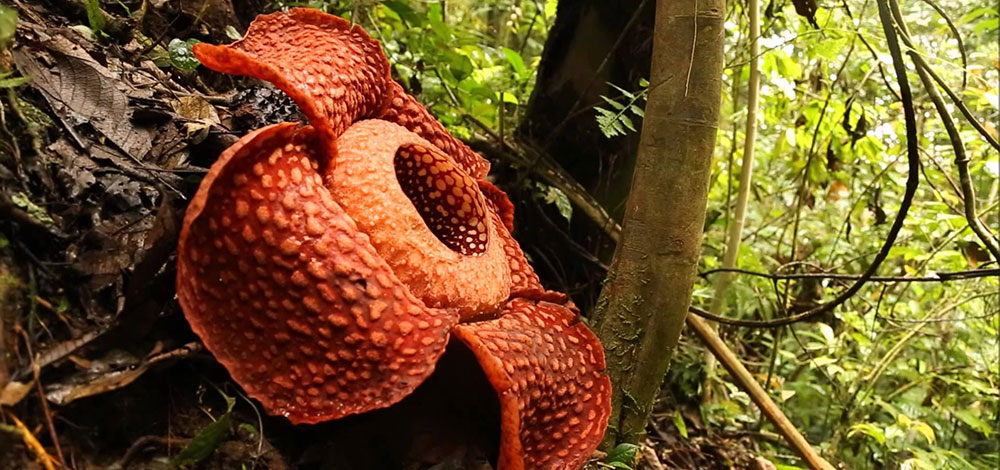
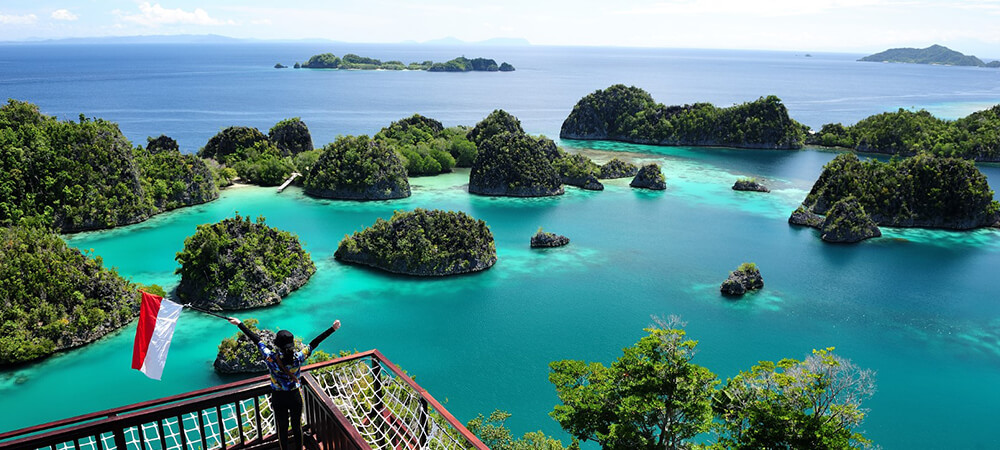
4. Raja Ampat
Raja Ampat is a living library for the world's coral reefs and a haven for marine life. The water is so clear and the coral so pristine, the area actually acts as a nursery for marine animals, re-stocking the Indian and Pacific Ocean populations of many species. Home to turtles, manta rays, sharks, seahorses, tuna and trevallies, alongside 540 types of corals, more than 1,000 types of coral fish, 13 mammal species and 700 types of mollusc, Raja Ampat is without doubt one of the most extraordinary natural wonders in the world.
5. Kelimutu National Park
On the eastern island of Flores, three volcanic lakes sit atop the summit of Kelimutu, greeting the sunrise with a shimmering and shape-shifting kaleidoscope of natural colours. Two of the deep crater lakes regularly change colour, caused by the concoction of minerals found in their waters Kelimutu's third lake remains an ever-present and iridescent shade of turquoise, glowing like a jewel in Kelimutu's sparse lunar landscape.
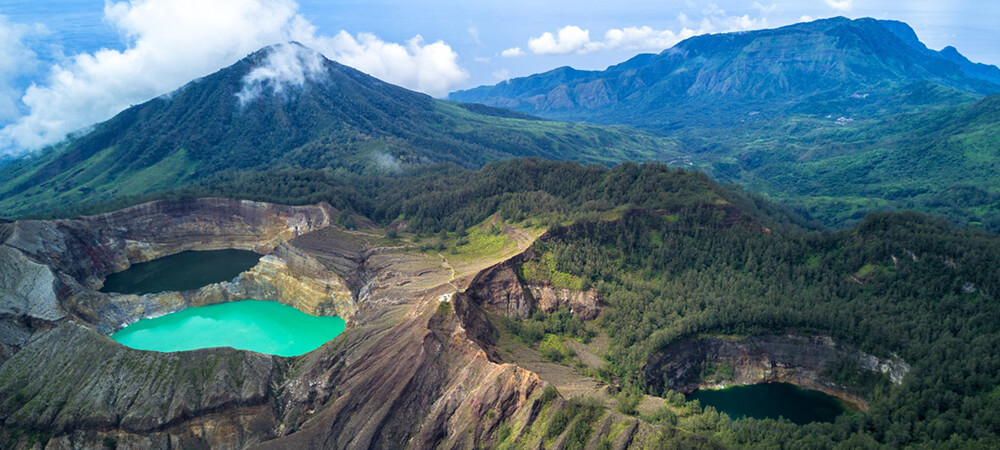
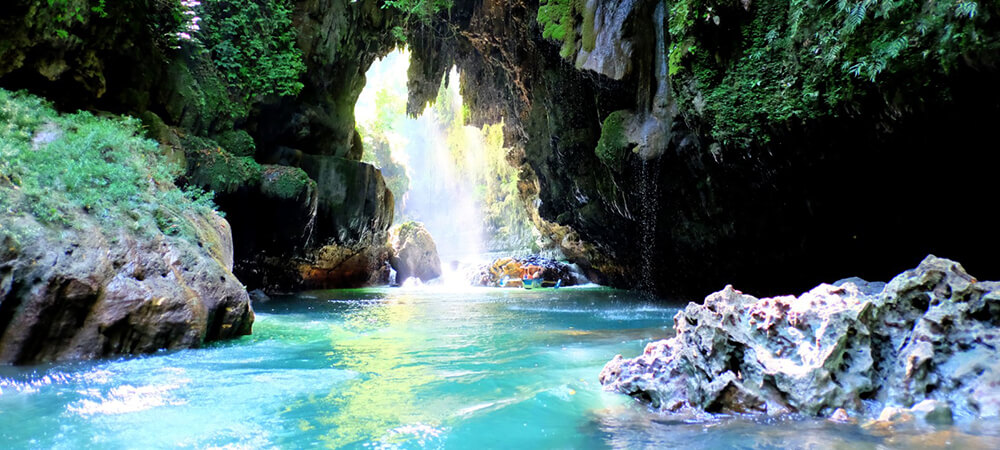
6. Green Canyon
Tucked away at the end of a labyrinth of winding mountain roads and jungle paths in West Java, Green Canyon snakes its way through the rocky valleys separating Pengandaran and Batu Karas. Here, rainwater from the forested highlands has made its way to the sea for thousands of years, carving deep ravines into the rock. This has created the spellbindingly beautiful natural wonder of Green Canyon; a serpentine stretch of bubbling streams, white water rapids and lazy pools, all framed by stunning rock formations, hanging vines and dense jungle foliage on both sides. Visitors to Green Canyon can fully immerse themselves in nature, with rafting, trekking and body surfing trips available.
7. Jayawijaya Mountain
Believe it or not, you can even find snow-capped mountains in Indonesia. This stunning natural wonder in Papua is home to seven individual summits, each one blanketed in a permanent shroud of snow. Located in Laurentz National Park, Papua, Jayawijaya is a fantastic destination for hiking and, as one of the highest points in all of Indonesia, offers up some staggering views.
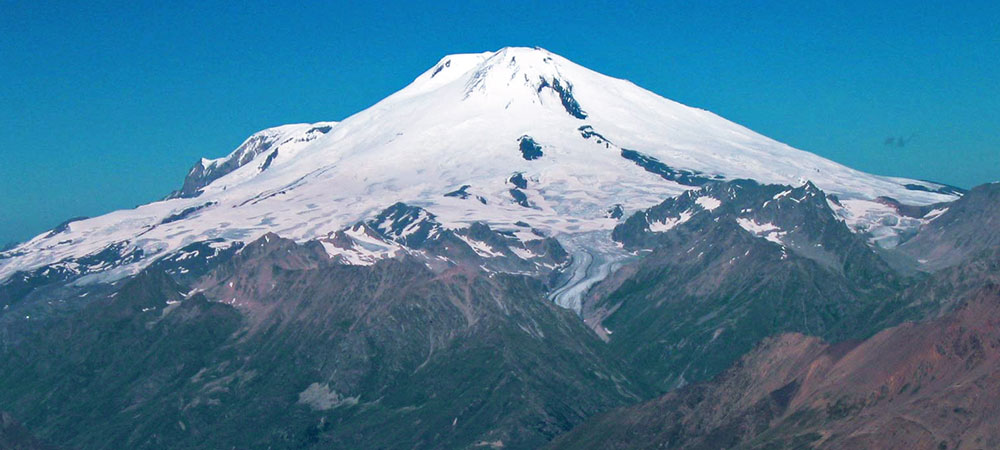
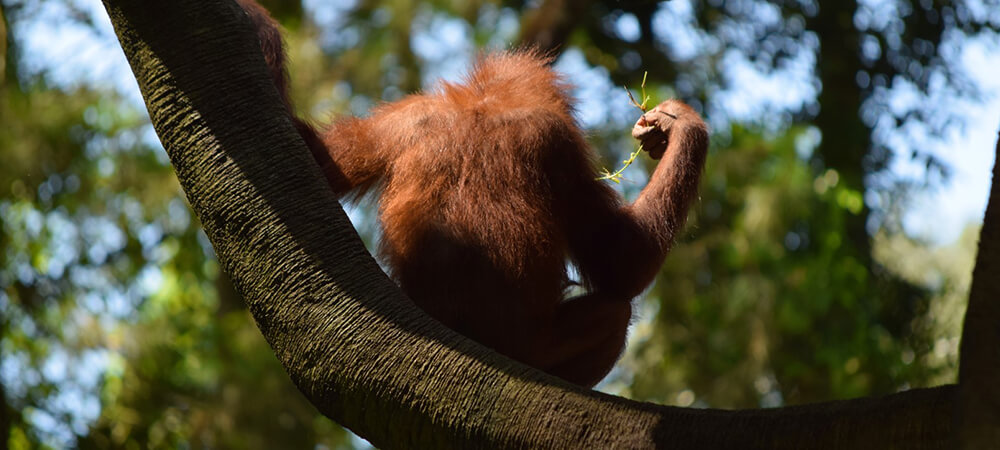
8. Tanjung Puting National Park
This enormous park in central Kalimantan is more than 4,000 sq km of tangled and steamy jungle, with winding rivers offering up wildlife encounters at every turn. Rustic but comfortable teak river boats travel up the Sungai Sekoneyer river, which flows through the park and stops at orangutan feeding stations. On board, travellers delve further and deeper day by day into the wild. Kingfishers and regal hornbills add a flash of colour along the river's banks, along with more than 200 other species of birds native to the area. As many as eight species of monkey – including the curious proboscis – call the park home, whilst each turn in the river may also reveal a crocodile sunning itself on the banks or slipping stealthily into the dark and mysterious waters of the river.
9. Menjangan Island
Menjangan Island is a part of the West Bali National Park and is home to many species of flora and fauna, including monkeys, deer, wild pigs and numerous birds indigenous to Bali. The island is a must for any visitor to Bali interested in marine life, snorkelling or diving; twelve different dive sites offer up crystalline waters, sheer walls, caves and a spectacular drop off. In addition to some of Bali’s best snorkelling and diving, Menjangan is also home to some eco projects, resorts and a small temple called Pura Gili Kencana, which is well worth a visit. The whole island can be circumnavigated in just a couple of hours, but with so many idyllic spots and so much captivating nature all around, it’s easy to dwell longer on this laid back little island.
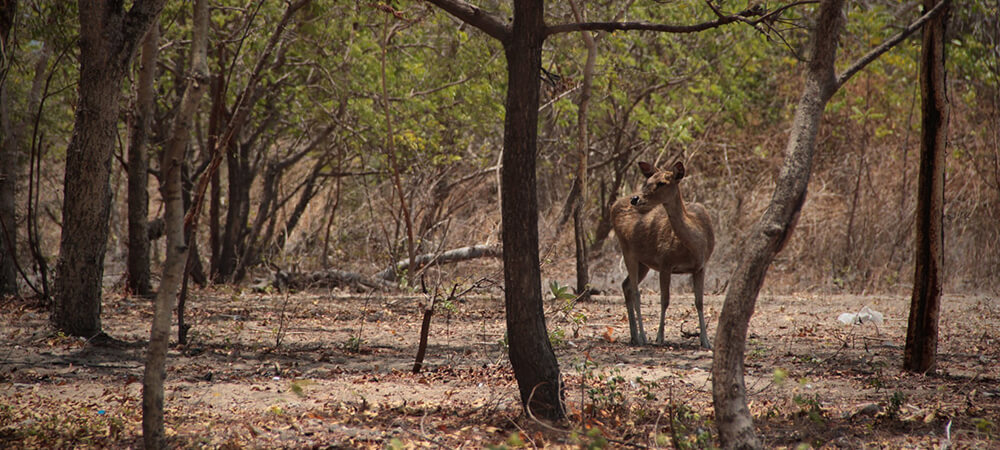
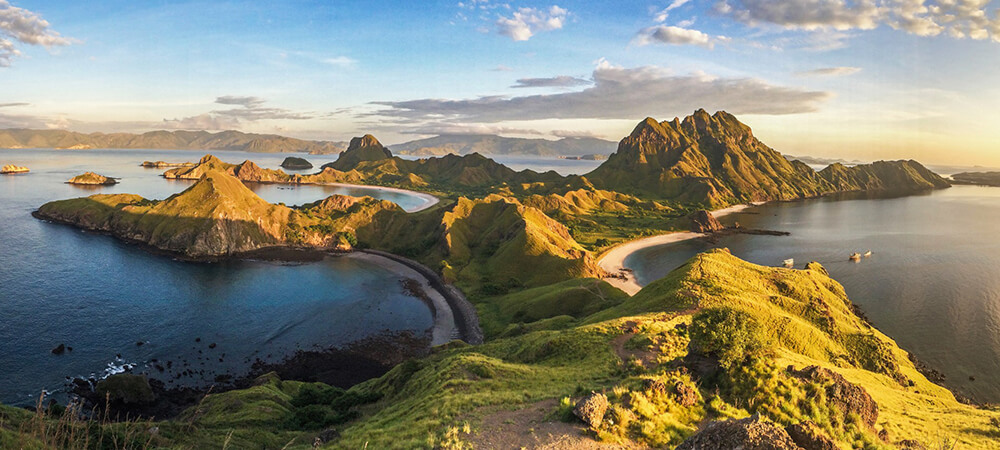
10. Komodo National Park
The islands of Komodo National Park are spectacular, rusty red volcanic outcrops with steep hillsides of sun-blasted rock, surrounded by immaculate coral gardens, mangroves and tropical shores. In addition to the world-famous dragons, the park is home to a rich diversity of birdlife, along with flying foxes, fruit bats, wild horses, long-tailed macaques, palm civets, boar and snakes. An Eden for wildlife of all kinds, plus a great place for trekking, spotting, swimming and diving, the park is home to 260 species of coral and 70 different sponges, along with sea turtles, dolphin, sharks and over 1,000 documented species of fish. Many boat trips are available to connect the surrounding islands or to simply explore the glorious seas stretching out towards the horizon all around.
1. Mount Bromo
Located in the Bromo-Tengger-Semeru National Park beside Mount Semeru in East Java, Mount Bromo remains one of the most active volcanoes in the world. Standing at 2,329 metres tall, Bromo is the most iconic and most hiked mountain in all of Indonesia. The main cone sits smouldering inside the massive Tengger caldera, covering an area of 10km and surrounded by the Laut Pasir (sea of sand); a desolate plateau of fine black volcanic sand and rock. Trekking across the vast rippling plain or traversing on horseback, travellers can get a unique panoramic view of a spectacular natural wonder. Visiting Bromo is an experience that is truly out of this world.

2. Lake Toba
At over 1,145 square km and with a depth of 450 meters, Toba is the largest lake in Southeast Asia and one of the deepest in the world. This awe-inspiring natural wonder in the heart of Sumatra is also home to some incredible scenery, winding mountain roads, historical treasures and fascinating cultural traditions. Situated 900 metres above sea level in the midst of volcanic peaks, the endless blue waters of Lake Toba fill a crater that was created by a series of huge eruptions around 75,000 years ago. Today, it remains one of the most breath-taking natural wonders to be found in Indonesia.

3. Rafflesia
Rafflesia; named after the British adventurer and discoverer of Singapore, Sir Stamford Raffles; is the largest flower in the world. This huge red and speckled five-petaled flower has a diameter of up to 106 cm, and weighs as much as 10 kg. It takes 21 months to fully mature and then flowers for only 5-7 days in the privacy of remote jungle clearings in Bengkulu, Sumatra. The stamen and pistils fuse together into a central column, producing a corona, or crown, in the shape of a ring. Aside from its colossal size, Rafflesia is known for its stomach-turning smell – a pungent aroma of death and carrion that attracts flies from miles around to act as pollinators for the seasonal flourish of this spectacular forest giant. This macabre perfume is also how the plant has acquired its nickname, ‘the corpse flower.’

4. Raja Ampat
Raja Ampat is a living library for the world's coral reefs and a haven for marine life. The water is so clear and the coral so pristine, the area actually acts as a nursery for marine animals, re-stocking the Indian and Pacific Ocean populations of many species. Home to turtles, manta rays, sharks, seahorses, tuna and trevallies, alongside 540 types of corals, more than 1,000 types of coral fish, 13 mammal species and 700 types of mollusc, Raja Ampat is without doubt one of the most extraordinary natural wonders in the world.

5. Kelimutu National Park
On the eastern island of Flores, three volcanic lakes sit atop the summit of Kelimutu, greeting the sunrise with a shimmering and shape-shifting kaleidoscope of natural colours. Two of the deep crater lakes regularly change colour, caused by the concoction of minerals found in their waters Kelimutu's third lake remains an ever-present and iridescent shade of turquoise, glowing like a jewel in Kelimutu's sparse lunar landscape.

6. Green Canyon
Tucked away at the end of a labyrinth of winding mountain roads and jungle paths in West Java, Green Canyon snakes its way through the rocky valleys separating Pengandaran and Batu Karas. Here, rainwater from the forested highlands has made its way to the sea for thousands of years, carving deep ravines into the rock. This has created the spellbindingly beautiful natural wonder of Green Canyon; a serpentine stretch of bubbling streams, white water rapids and lazy pools, all framed by stunning rock formations, hanging vines and dense jungle foliage on both sides. Visitors to Green Canyon can fully immerse themselves in nature, with rafting, trekking and body surfing trips available.

7. Jayawijaya Mountain
Believe it or not, you can even find snow-capped mountains in Indonesia. This stunning natural wonder in Papua is home to seven individual summits, each one blanketed in a permanent shroud of snow. Located in Laurentz National Park, Papua, Jayawijaya is a fantastic destination for hiking and, as one of the highest points in all of Indonesia, offers up some staggering views.

8. Tanjung Puting National Park
This enormous park in central Kalimantan is more than 4,000 sq km of tangled and steamy jungle, with winding rivers offering up wildlife encounters at every turn. Rustic but comfortable teak river boats travel up the Sungai Sekoneyer river, which flows through the park and stops at orangutan feeding stations. On board, travellers delve further and deeper day by day into the wild. Kingfishers and regal hornbills add a flash of colour along the river's banks, along with more than 200 other species of birds native to the area. As many as eight species of monkey – including the curious proboscis – call the park home, whilst each turn in the river may also reveal a crocodile sunning itself on the banks or slipping stealthily into the dark and mysterious waters of the river.

9. Menjangan Island
Menjangan Island is a part of the West Bali National Park and is home to many species of flora and fauna, including monkeys, deer, wild pigs and numerous birds indigenous to Bali. The island is a must for any visitor to Bali interested in marine life, snorkelling or diving; twelve different dive sites offer up crystalline waters, sheer walls, caves and a spectacular drop off. In addition to some of Bali’s best snorkelling and diving, Menjangan is also home to some eco projects, resorts and a small temple called Pura Gili Kencana, which is well worth a visit. The whole island can be circumnavigated in just a couple of hours, but with so many idyllic spots and so much captivating nature all around, it’s easy to dwell longer on this laid back little island.

10. Komodo National Park
The islands of Komodo National Park are spectacular, rusty red volcanic outcrops with steep hillsides of sun-blasted rock, surrounded by immaculate coral gardens, mangroves and tropical shores. In addition to the world-famous dragons, the park is home to a rich diversity of birdlife, along with flying foxes, fruit bats, wild horses, long-tailed macaques, palm civets, boar and snakes. An Eden for wildlife of all kinds, plus a great place for trekking, spotting, swimming and diving, the park is home to 260 species of coral and 70 different sponges, along with sea turtles, dolphin, sharks and over 1,000 documented species of fish. Many boat trips are available to connect the surrounding islands or to simply explore the glorious seas stretching out towards the horizon all around.

Top 5 Indonesian Destinations To Visit In 2023
3rd July 2022
With borders open and tourism back in business, international travellers can finally start planning their trip to Indonesia. There’s always somewhere new to explore in this enormous archipelago. In our latest Travel Tips, we take a look at five of […]
READ MOREBeyond Covid: 5 Tips For Safer Travel
18th November 2020
With borders reopening, travel restrictions being lifted and new visas now available, we can finally begin planning those long-awaited holidays in Thailand! After so long in lockdown, many travellers are nervous about heading abroad and want to know how they can stay safe. […]
READ MORETop 5 Experiences In Malaysia
30th October 2020
Lockdown getting you down? Maybe it’s time to start looking ahead to post-pandemic travel. With its unique blend of cosmopolitan culture, amazing food and wonderful nature, Malaysia is a holiday destination that packs in all your favourite holiday features. When Covid-19 restrictions are finally […]
READ MORETop 5: Adventures In East Java
25th October 2020
Looking for a little travel inspiration to keep you warm this winter? With a fiery mix of spice, volcanoes, artistry, tobacco and sunshine, East Java is the perfect place to get away from it all and turn up the heat […]
READ MOREThailand: Top Picks
21st October 2020
Looking forward to a little summer sun after months of lockdown? With Covid-19 restrictions finally being lifted and flights returning to Thailand, now is the time to start planning ahead for that long-awaited and much-anticipated getaway. If you’re wondering where to begin, Panorama […]
READ MORE5 Tips For Thai Animal Tourism
23rd September 2020
From elephants and tigers to dolphins, turtles and whales, Thailand offers some of the most amazing wildlife the world has to offer. However, tourism and the natural world don’t always mix. In this article, we provide some practical tips for travellers in Thailand. Our goal is to provide unique, […]
READ MORECommon Problems & Solutions
10th February 2020
Travelling in Thailand is an unforgettable experience; the majority of visitors to the Land of Smiles leave with only positive stories to tell. However, as with all travel in far-flung places, things can occasionally go wrong. To ensure you remember […]
READ MOREIndonesia Do’s And Don’ts
21st January 2020
Indonesia is a complex and welcoming place. In an archipelago of more than 17,000 islands, you’ll find that everyone has their own unique style, their own traditions and a dash of flavour to add to the melting pot of this […]
READ MOREUnesco City Of Gastronomy – Phuket Town
5th July 2019
Phuket Town is known for many things: historical architecture, spectacular beaches and vibrant nightlife. But one thing that keeps visitors coming back for more is the food; with an amazing array of local delicacies, there’s something here to satisfy every […]
READ MOREThailand Do’s And Don’ts
26th April 2019
When travelling in Thailand, one of the first things you’ll notice is how hospitable and friendly Thai people are in welcoming outsiders to their country. However, there are some important cultural customs to bear in mind when visiting. If you’re […]
READ MORETop 10: Beaches In Phuket
3rd September 2018
Looking for postcard-perfect beach breaks in Phuket? Thailand’s favourite island is perfectly located in the warm and tranquil waters of the Andaman Sea, and is home to some of the country’s most iconic beaches. You’ll find most of them along […]
READ MORETop 10: Bars & Clubs In Jakarta
3rd January 2018
Jakarta, the frenetic capital of Indonesia, is the bustling backdrop for some of the best nightlife Southeast Asia has to offer. From rooftop cocktail bars overlooking cityscapes, to elite socialite lounges and subterranean clubs spinning the best underground beats. The […]
READ MORETop 10: Bars & Clubs In Bali
2nd January 2018
Most of the best nightclubs in Bali are located within the Kuta and Seminyak area, whilst a great selection of beachfront and rooftop bars has sprung up all over the island’s major tourism hotspots. Kuta’s reasonable prices and laid-back party […]
READ MORE5 Reasons To Book Bali Now
15th December 2017
Now that the recent eruptions from Mount Agung have subsided, Bali is back to its beautiful best. If you’re thinking about Bali for your next holiday, but unsure whether the time is right, take a look below; you’ll see that […]
READ MORETop 10: Street Foods In Thailand
30th November 2017
Wherever you go in Thailand, you’ll find that as soon as the sun goes down – and sometimes before – the streets fill up with tables and chairs, the fragrant air cools and thickens with cooking smoke and every available […]
READ MORETop Festivals In Thailand
17th November 2017
In Thailand, the calendar is packed with weird and wonderful events – outlandish festivals and celebrations that are the perfect excuse to party. From food festivals to rocket races, buffalo beauty pageants and underwater weddings, there’s plenty to see and […]
READ MORETop 10: Things To See In Bali
16th November 2017
Bali is quite rightly regarded as one of the best destinations in the world for travellers. With its intoxicating blend of beautiful landscapes, tropical climate, unique cultural traditions and natural wonders, the island has much to offer. In this list, […]
READ MORE7 Places Off The Beaten Track In East Lombok
4th May 2017
The east of Lombok is an area filled with many hidden treasures. For intrepid travellers with wanderlust and a taste for solitude, many adventures await at the end of the road. In this article, we feature seven of the best-kept […]
READ MORE7 Reasons To Visit Raja Ampat
21st March 2017
Beauty above and below the waves Thanks to Raja Ampat’s remote location and its many coral labyrinths, this is an ecosystem and a landscape that has remained largely untouched by man; a serene and beautiful Eden, where nature flourishes in […]
READ MORETop 10: Natural Wonders Of Indonesia
16th March 2017
Indonesia is a cluster of volcanic and tropical islands speckled along the ring of fire, which splits the Indian and Pacific oceans and straddles the equator. More than 17,000 islands make up a star-studded landscape home to volcanoes, jungles, lakes, […]
READ MORETop 10: Indonesian Island Getaways
13th March 2017
There are more than 17,000 islands to be discovered in Indonesia. Each one offers travellers a unique and unforgettable experience, with volcanoes, rainforests, coral gardens, ancient villages and lazy days spent in the sun. In this article, we take a […]
READ MORETop 10: Indonesian Street Foods
9th March 2017
They say the heart of a home is its kitchen; that the soul of a city is on its streets. In Indonesia, the street is the kitchen, where cooks keep a fire burning all day long and the food is […]
READ MORETop 10: Incredible Animal Encounters In Indonesia
2nd March 2017
The name comes from the Malay language, meaning ‘man of the forest’, and this gentle ginger ape is one of our closest cousins; Orangutan share 96.4% of our genes. Dedicated and loving parents, these great apes are highly intelligent creatures, […]
READ MORETop 10: Diving Destinations In Indonesia
22nd February 2017
17,000 islands, 80,000 kilometers of coastline, 3.1 million square kilometers of territorial waters, 3,000 fish species, and 600 coral species—it all adds up to the ultimate scuba experience. In Indonesia you’ll find excellent shallow reef diving, as well as deep […]
READ MORETop 10: Festivals And Celebrations Of Indonesia
20th February 2017
In Indonesia, the calendar is filled with festivals and celebrations, both traditional and contemporary. Thanks to its bewildering array of languages, ethnicities, traditions and beliefs, Indonesia offers visitors an infinite set of showpieces, some of which date back to prehistory. […]
READ MORE10 Things To Pack When Traveling To Indonesia
19th February 2017
So, your ticket’s booked and Indonesia is finally going to happen. Pretty soon you’ll be living all those picture postcard moments in paradise. With so many adventures ahead, it’s hard to know how best to prepare. Not to worry – […]
READ MORETop 5 Indonesian Destinations To Visit In 2023
With borders open and tourism back in business, international travellers can finally start planning their trip to Indonesia. There’s always somewhere new to explore in this enormous archipelago. In our latest Travel Tips, we take a look at five of […]
Beyond Covid: 5 Tips For Safer Travel
With borders reopening, travel restrictions being lifted and new visas now available, we can finally begin planning those long-awaited holidays in Thailand! After so long in lockdown, many travellers are nervous about heading abroad and want to know how they can stay safe. […]
Top 5 Experiences In Malaysia
Lockdown getting you down? Maybe it’s time to start looking ahead to post-pandemic travel. With its unique blend of cosmopolitan culture, amazing food and wonderful nature, Malaysia is a holiday destination that packs in all your favourite holiday features. When Covid-19 restrictions are finally […]
Top 5: Adventures In East Java
Looking for a little travel inspiration to keep you warm this winter? With a fiery mix of spice, volcanoes, artistry, tobacco and sunshine, East Java is the perfect place to get away from it all and turn up the heat […]
Thailand: Top Picks
Looking forward to a little summer sun after months of lockdown? With Covid-19 restrictions finally being lifted and flights returning to Thailand, now is the time to start planning ahead for that long-awaited and much-anticipated getaway. If you’re wondering where to begin, Panorama […]
5 Tips For Thai Animal Tourism
From elephants and tigers to dolphins, turtles and whales, Thailand offers some of the most amazing wildlife the world has to offer. However, tourism and the natural world don’t always mix. In this article, we provide some practical tips for travellers in Thailand. Our goal is to provide unique, […]
Common Problems & Solutions
Travelling in Thailand is an unforgettable experience; the majority of visitors to the Land of Smiles leave with only positive stories to tell. However, as with all travel in far-flung places, things can occasionally go wrong. To ensure you remember […]
Indonesia Do’s And Don’ts
Indonesia is a complex and welcoming place. In an archipelago of more than 17,000 islands, you’ll find that everyone has their own unique style, their own traditions and a dash of flavour to add to the melting pot of this […]
Unesco City Of Gastronomy – Phuket Town
Phuket Town is known for many things: historical architecture, spectacular beaches and vibrant nightlife. But one thing that keeps visitors coming back for more is the food; with an amazing array of local delicacies, there’s something here to satisfy every […]
Thailand Do’s And Don’ts
When travelling in Thailand, one of the first things you’ll notice is how hospitable and friendly Thai people are in welcoming outsiders to their country. However, there are some important cultural customs to bear in mind when visiting. If you’re […]
Top 10: Beaches In Phuket
Looking for postcard-perfect beach breaks in Phuket? Thailand’s favourite island is perfectly located in the warm and tranquil waters of the Andaman Sea, and is home to some of the country’s most iconic beaches. You’ll find most of them along […]
Top 10: Bars & Clubs In Jakarta
Jakarta, the frenetic capital of Indonesia, is the bustling backdrop for some of the best nightlife Southeast Asia has to offer. From rooftop cocktail bars overlooking cityscapes, to elite socialite lounges and subterranean clubs spinning the best underground beats. The […]
Top 10: Bars & Clubs In Bali
Most of the best nightclubs in Bali are located within the Kuta and Seminyak area, whilst a great selection of beachfront and rooftop bars has sprung up all over the island’s major tourism hotspots. Kuta’s reasonable prices and laid-back party […]
5 Reasons To Book Bali Now
Now that the recent eruptions from Mount Agung have subsided, Bali is back to its beautiful best. If you’re thinking about Bali for your next holiday, but unsure whether the time is right, take a look below; you’ll see that […]
Top 10: Street Foods In Thailand
Wherever you go in Thailand, you’ll find that as soon as the sun goes down – and sometimes before – the streets fill up with tables and chairs, the fragrant air cools and thickens with cooking smoke and every available […]
Top Festivals In Thailand
In Thailand, the calendar is packed with weird and wonderful events – outlandish festivals and celebrations that are the perfect excuse to party. From food festivals to rocket races, buffalo beauty pageants and underwater weddings, there’s plenty to see and […]
Top 10: Things To See In Bali
Bali is quite rightly regarded as one of the best destinations in the world for travellers. With its intoxicating blend of beautiful landscapes, tropical climate, unique cultural traditions and natural wonders, the island has much to offer. In this list, […]
7 Places Off The Beaten Track In East Lombok
The east of Lombok is an area filled with many hidden treasures. For intrepid travellers with wanderlust and a taste for solitude, many adventures await at the end of the road. In this article, we feature seven of the best-kept […]
7 Reasons To Visit Raja Ampat
Beauty above and below the waves Thanks to Raja Ampat’s remote location and its many coral labyrinths, this is an ecosystem and a landscape that has remained largely untouched by man; a serene and beautiful Eden, where nature flourishes in […]
Top 10: Natural Wonders Of Indonesia
Indonesia is a cluster of volcanic and tropical islands speckled along the ring of fire, which splits the Indian and Pacific oceans and straddles the equator. More than 17,000 islands make up a star-studded landscape home to volcanoes, jungles, lakes, […]
Top 10: Indonesian Island Getaways
There are more than 17,000 islands to be discovered in Indonesia. Each one offers travellers a unique and unforgettable experience, with volcanoes, rainforests, coral gardens, ancient villages and lazy days spent in the sun. In this article, we take a […]
Top 10: Indonesian Street Foods
They say the heart of a home is its kitchen; that the soul of a city is on its streets. In Indonesia, the street is the kitchen, where cooks keep a fire burning all day long and the food is […]
Top 10: Incredible Animal Encounters In Indonesia
The name comes from the Malay language, meaning ‘man of the forest’, and this gentle ginger ape is one of our closest cousins; Orangutan share 96.4% of our genes. Dedicated and loving parents, these great apes are highly intelligent creatures, […]
Top 10: Diving Destinations In Indonesia
17,000 islands, 80,000 kilometers of coastline, 3.1 million square kilometers of territorial waters, 3,000 fish species, and 600 coral species—it all adds up to the ultimate scuba experience. In Indonesia you’ll find excellent shallow reef diving, as well as deep […]
Top 10: Festivals And Celebrations Of Indonesia
In Indonesia, the calendar is filled with festivals and celebrations, both traditional and contemporary. Thanks to its bewildering array of languages, ethnicities, traditions and beliefs, Indonesia offers visitors an infinite set of showpieces, some of which date back to prehistory. […]
10 Things To Pack When Traveling To Indonesia
So, your ticket’s booked and Indonesia is finally going to happen. Pretty soon you’ll be living all those picture postcard moments in paradise. With so many adventures ahead, it’s hard to know how best to prepare. Not to worry – […]
